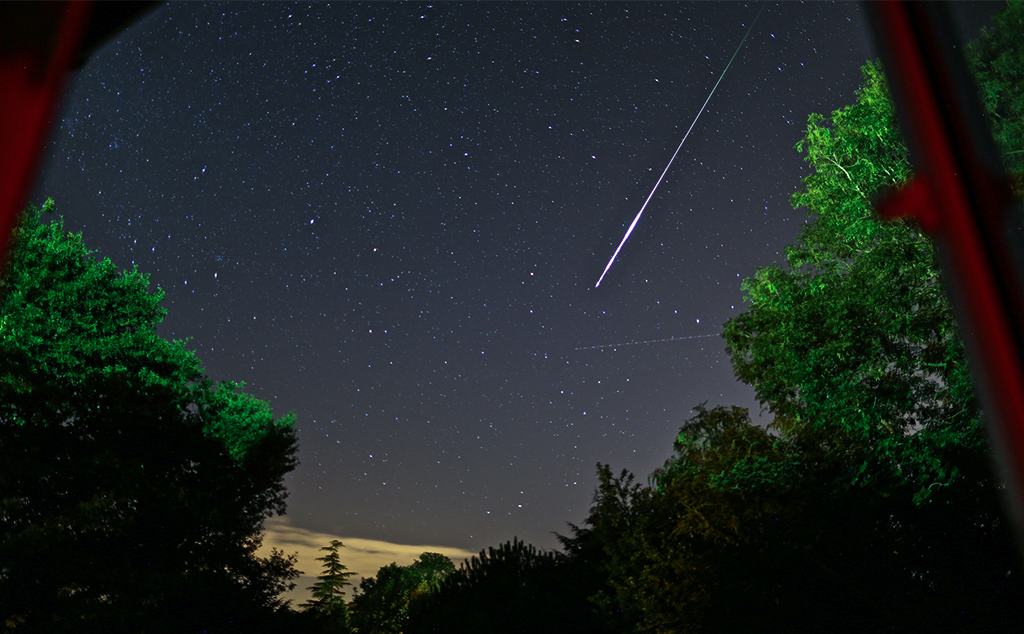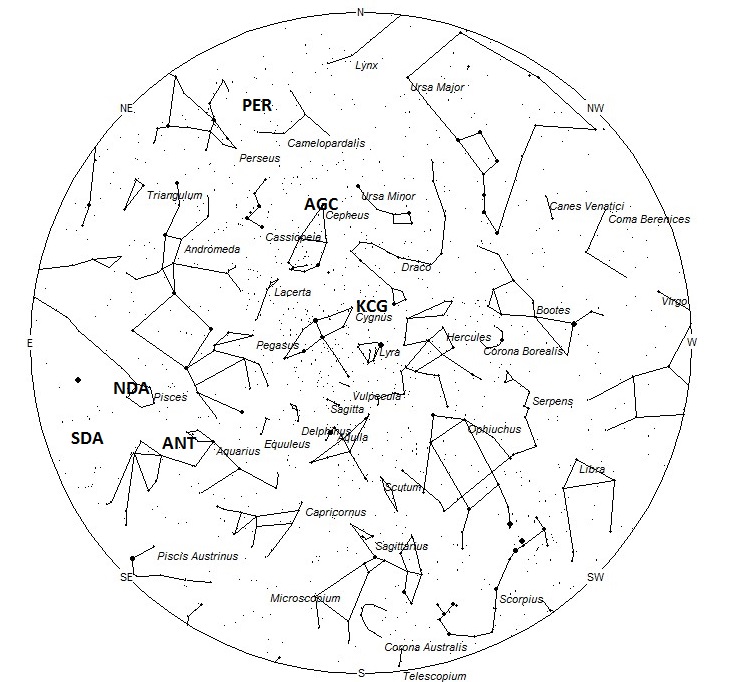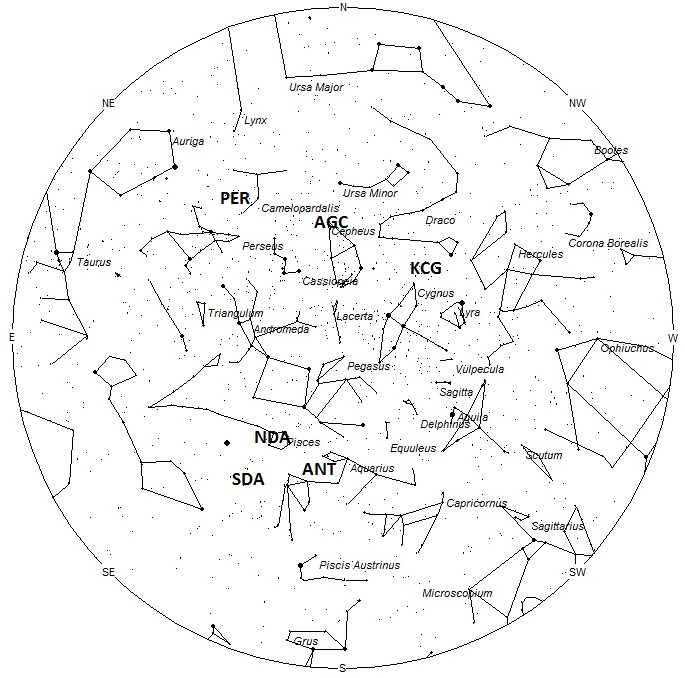
During this period the moon reaches its last quarter phase on Thursday August 25th. At this time the moon will lie 90 degrees west of the sun and will rise near midnight local daylight saving time (LDST) for observers located at mid-northern latitudes. This weekend the waning gibbous moon will rise around 2100 (9pm LDST) and will remain above the horizon the remainder of the night. The bright moon will obscure many of the fainter meteors that would otherwise be seen in a darker sky. The estimated total hourly meteor rates for evening observers this week is near 3 for observers located in the northern hemisphere and 2 for observers located in tropical southern locations (25S). For morning observers the estimated total hourly rates should be near 15 for observers located in the northern hemisphere and 12 for observers located in tropical southern locations (25S). The actual rates will also depend on factors such as personal light and motion perception, local weather conditions, alertness and experience in watching meteor activity. Note that the hourly rates listed below are estimates as viewed from dark sky sites away from urban light sources. Observers viewing from urban areas will see less activity as only the brightest meteors will be visible from such locations. Rates during this period are reduced due to interfering moonlight.
The radiant (the area of the sky where meteors appear to shoot from) positions and rates listed below are exact for Saturday night/Sunday morning August 20/21. These positions do not change greatly day to day so the listed coordinates may be used during this entire period. Most star atlases (available at science stores and planetariums) will provide maps with grid lines of the celestial coordinates so that you may find out exactly where these positions are located in the sky. A planisphere or computer planetarium program is also useful in showing the sky at any time of night on any date of the year. Activity from each radiant is best seen when it is positioned highest in the sky, either due north or south along the meridian, depending on your latitude. It must be remembered that meteor activity is rarely seen at the radiant position. Rather they shoot outwards from the radiant so it is best to center your field of view so that the radiant lies at the edge and not the center. Viewing there will allow you to easily trace the path of each meteor back to the radiant (if it is a shower member) or in another direction if it is a sporadic. Meteor activity is not seen from radiants that are located far below the horizon. The positions below are listed in a west to east manner in order of right ascension (celestial longitude). The positions listed first are located further west therefore are accessible earlier in the night while those listed further down the list rise later in the night.
These sources of meteoric activity are expected to be active this week.
Details of each source will continue next week when moonlight conditions will be more favorable.
| SHOWER | DATE OF MAXIMUM ACTIVITY | CELESTIAL POSITION | ENTRY VELOCITY | CULMINATION | HOURLY RATE | CLASS |
|---|---|---|---|---|---|---|
| RA (RA in Deg.) DEC | Km/Sec | Local Daylight Saving Time | North-South | |||
| kappa Cygnids (KCG) | Aug 17 | 18:20 (275) +55 | 19 | 23:00 | 1 – <1 | II |
| Anthelions (ANT) | – | 22:44 (341) -09 | 29 | 02:00 | 1 – 2 | II |
| North delta Aquariids (NDA) | Aug 19 | 23:36 (354) +05 | 41 | 03:00 | 1 – 1 | IV |
| August gamma Cepheids (AGC) | Aug 28 | 23:54 (359) +77 | 41 | 03:00 | <1 – <1 | IV |
| South delta Aquariids (SDA) | Jul 28 | 00:04 (001) -10 | 42 | 03:00 | <1 – 1 | I |
| Perseids (PER) | Aug 12 | 04:04 (061) +60 | 61 | 07:00 | 3 – 1 | I |
 American Meteor Society
American Meteor Society



Here’s my Perseids summary report:
Location: Cottonwood, central valley, northern California
Viewing days 8-07 thru 8-13
Viewing time start: 0100 LDT
Viewing duration: 3 hrs
General Comments:
High Sporadic rates throughout period. Most tracked S-N, and lesser amounts W-E. Very few N-S or E-W oriented sporadics noted, Several sporadics were very bright with smoke trains, but no residual fluorescence.
Max Perseids Zhr occurred 0130-0230 LDT on 8-12. Zhr was ~80 during this time with several fireballs and very bright meteors with visible trails. After 0300, meteors rates fell off significantly, with fewer fireballs and bright meteors. Note: for all viewing days, maximum activity peaked (both sporadics and Perseids) between 0130 and 0300 LDT. Meteors after 0300 trended smaller with fewer bright meteors or meteors with long trails. Brightest meteor seen was a fragmenting bolide @ 0258 on 8-13 which produced a vivid smoke trail with residual fluorescence lasting ~30 seconds. This was the only bolide seen, as well as the only one with a fluorescent;
Data summary:
8-08-16:
72 total meteors, 42 Perseids with numerous very bright meteors and 3 fireballs. Sporadic rates also elevated, with strong S-N tendencies. Perseid activity also favoring visual locations south of Perseus.
8-09-16:
54 total meteors, 22 Perseids. Trends in location and direction of both sporadic and Perseid meteors remained unchanged from previous night.
8-10-16 through 08-11-16:
Same general activity pattern with brightest meteors occurring before 0230 LDT. Zhr slowly diminishing to ~ 20/hr.
8-12-16
Shower peak.
187 total meteors, 138 Perseids. Highest Zhr between 0100 and 0200 ~ 75/hr. Zhr then dropped to ~ 50 thereafter. Overall Zhr pretty consistent at 50-60/hr. No significant outbursts noted, with brief flurries of only 2-3 at a time.
8-13-16:
106 total meteors, 73 Perseids. Many bright Perseids between 0100 and 0200. Two bright slow-speed sporadics tracking S-N produced long smoke trails but no residual fluorescence. One Perseid bolide at 0258. Was the brightest meteor seen for entire week.
Other notes for the entire week of viewing (16 hrs total):
# Red meteors: 13
# Blue meteors: 18
# Green meteors: 3
# Fireballs (> -5 Vm): 9
# Bolides: 1
We are located on the Northshore of Kauai,2:30 AM we saw 5 white streakers within 6-7 minutes,totally caught off guard because we were not looking for meteors,we just went out to see the magnificent sky between rain shower’s.What a treat it was!
From Janie Langley,This occurred this morning 8-28-2016,not three weeks ago.We watch the Persied Shower every August.It was not the event we expected,this morning was more of an event although the meteors were not as long as the Persied meteors,about 1/3 the length .